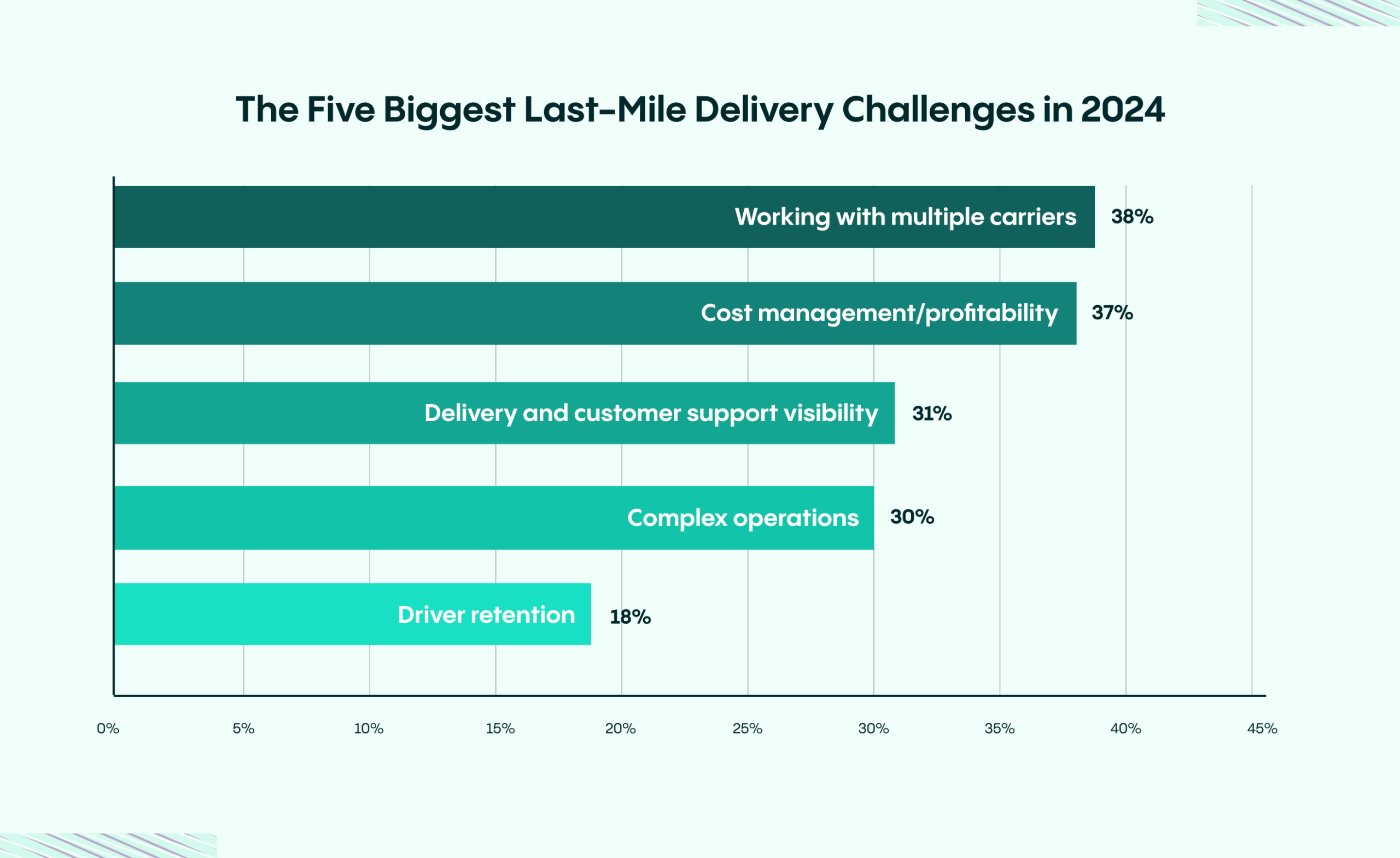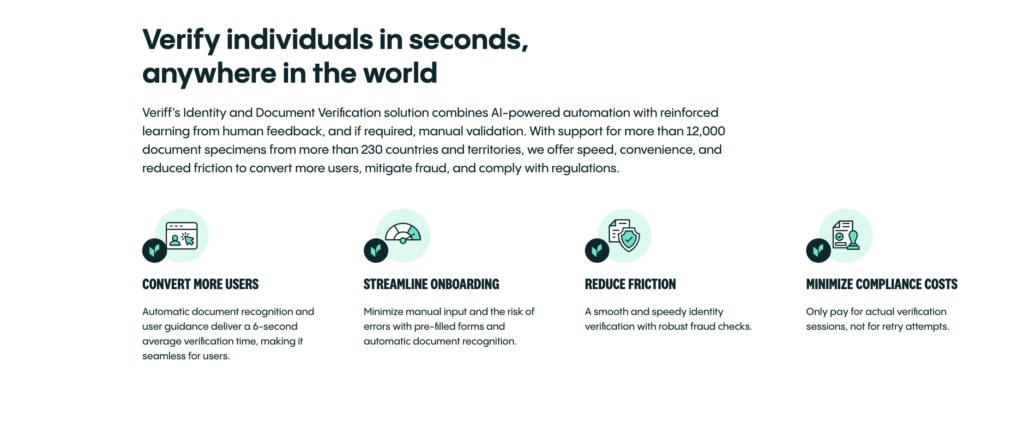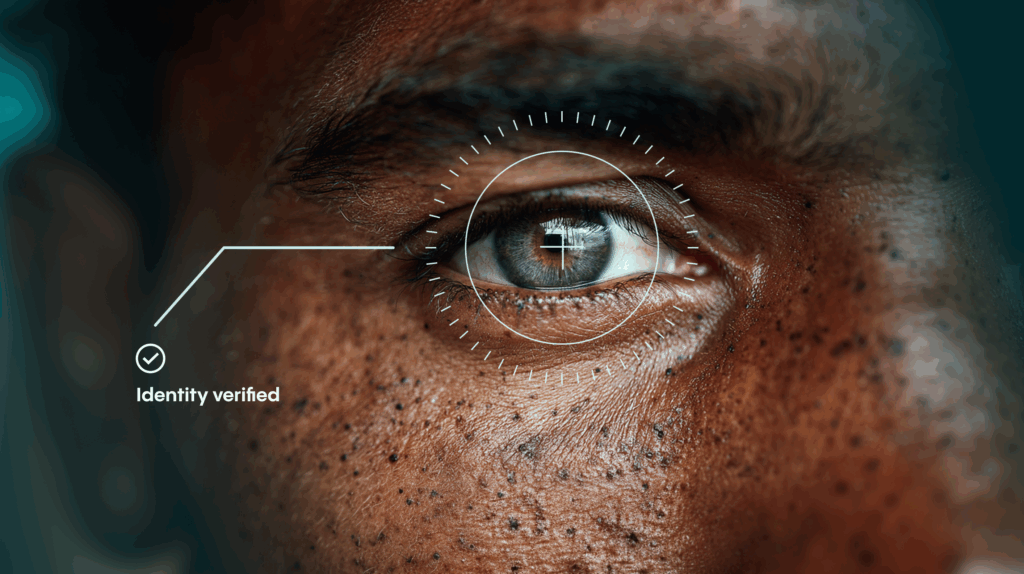IDV Article
Last-mile delivery: Why Identity Verification is your secret weapon
Last-mile delivery is where costs surge, complexity peaks, and customer patience runs thin. It’s 30–40% of transport costs, with 65% of shoppers ditching retailers after 2–3 late deliveries. Mastering it means protecting trust, loyalty, and growth.

Last-mile delivery has become one of the most pressing challenges in modern logistics. For retailers, especially those dealing with big and bulky goods, the final stretch from distribution hub to customer doorstep is not only the most complex part of the supply chain, but also the most expensive. According to Bringg’s 2025 State of Last-Mile Report, 77% of retailers say the last mile is the most challenging step in the supply chain, accounting for 30–40% of total transportation costs. At the same time, consumer expectations are unforgiving: 65% of shoppers say they’ll abandon a retailer after just two or three late deliveries, and 81% will walk away after repeated incorrect orders. In this high-stakes environment, perfecting the last mile isn’t just a matter of efficiency; it’s a make-or-break factor for customer trust, loyalty, and long-term business growth.
The five biggest last-mile delivery challenges
Last-mile delivery has become one of the most critical—and costly—links in the supply chain. As customer expectations for speed and transparency rise, retailers in the UK and the U.S. are grappling with mounting operational pressures. A 2024 survey of retail and logistics professionals revealed that challenges such as managing multiple carriers, keeping costs under control, maintaining visibility, navigating complex operations, and retaining drivers remain top concerns. Below, we break down the five biggest hurdles shaping last-mile delivery today and explore why overcoming them is vital for sustainable growth and customer satisfaction.
- Working with multiple carriers
In 2024, nearly four in ten retail and logistics professionals in the UK and the U.S. cited managing multiple carriers as their top challenge. Juggling different service providers leads to inconsistent performance, fragmented visibility, and higher operational complexity. Without a unified system, retailers struggle to deliver a seamless experience to customers. - Cost management and profitability
Last-mile delivery often accounts for more than 50% of total shipping expenses. Issues such as inefficient routes, failed drop-offs, fuel usage, and labor costs all play a role in driving up these costs. Maintaining profitability in delivery operations is another significant challenge; 37% of industry professionals recognize cost management as a major obstacle. Increasing fuel prices, variable labor expenses, and unoptimized routes continue to strain already tight profit margins. Businesses must find a way to meet competitive delivery expectations while keeping costs under control.
- Delivery and customer support visibility
Customers expect full transparency—real-time tracking, proactive communication, and swift problem resolution. Yet 31% of respondents reported visibility gaps in delivery and support. These blind spots frustrate customers and erode trust, while also making it harder for businesses to proactively manage exceptions. - Complex operations and compliance
From coordinating fleets to navigating regulations, 30% of professionals noted the sheer complexity of last-mile delivery as a top concern. Expanding into new regions magnifies this issue, especially for age-restricted goods like alcohol or pharmaceuticals, where regulatory compliance failures can trigger fines, reputational damage, or even revoked licenses. - Driver retention and identity verification
Behind the logistics, people power matters. Driver retention remains a concern for 18% of professionals, and the challenge is to verify both drivers and recipients. Traditional ID checks are slow and error-prone, but the risks of getting it wrong—such as fraud or underage deliveries—are immense. Investing in scalable identity verification technology is becoming essential to keeping last-mile delivery secure and compliant.

Smart solutions that actually work
Route optimization and AI-powered planning
AI-powered routing software is revolutionizing delivery operations by optimizing routes based on traffic patterns, delivery time windows, vehicle capacity, and driver locations. As retailers increase their investment in AI-driven technologies for orchestration, automation, and real-time operations in 2025, these systems have become essential for maintaining efficiency and staying competitive. By dynamically planning the most efficient routes, automating driver dispatch to match the right driver with the right job, and reducing manual planning, fuel consumption, and staffing needs, AI and machine learning are streamlining delivery processes and driving significant operational improvements.
Real-time tracking and customer communication
Real-time visibility tools (invested in by 72% of retailers) serve dual purposes: enhancing operational agility and making the customer part of the process. Providing customers with real-time tracking and notifications is essential. This not only meets their expectations for transparency but also reduces “where’s my order?” inquiries and can help prevent failed deliveries by alerting customers to a driver’s arrival. Keeping customers informed during disruptions builds trust and reduces frustration.
Strategic network design
A high-performing last-mile strategy directly impacts conversion, loyalty, and lifetime customer value for 75% of retailers. Many brands utilize 3PLs regionally to enable same‑day delivery—about 48% report success there, but managing these outsourced networks effectively demands strong orchestration and visibility systems. Businesses can reduce delivery distances, time, and costs by locating warehouses and fulfillment centers closer to their customers. This model, often called “micro-fulfillment,” allows for faster local deliveries.
Alternative delivery models
To reduce costs and improve flexibility, companies are adopting innovative delivery models that cater to customer convenience and environmental sustainability. Parcel lockers and pickup points allow customers to retrieve packages at their convenience, minimizing failed deliveries and reducing the need for multiple delivery attempts. Crowdsourced and gig economy drivers provide on-demand capacity and greater flexibility, particularly during peak seasons. Additionally, sustainable fleets, including electric or hybrid vehicles, bicycles, and pedestrian couriers, are being utilized in urban areas to lower environmental impact and navigate traffic more efficiently. Together, these approaches transform the logistics landscape.

Last-mile delivery: Identity Verification is your secret weapon
Struggling with courier fraud, failed drop-offs, or age-restricted deliveries? Veriff helps last-mile operators secure every delivery, keep customers happy, and stay compliant.
How Veriff solves last-mile problems
This is where comprehensive identity verification becomes a game-changer. Modern verification solutions address How Veriff solves last-mile challenges
Veriff’s comprehensive identity verification solutions are designed to address the unique challenges of last-mile delivery, ensuring seamless operations, regulatory compliance, and enhanced safety for all stakeholders. By combining advanced technology with customizable verification options, Veriff empowers businesses to deliver securely and efficiently.
Preventing courier-side fraud
Fraud committed by couriers can disrupt operations and damage trust. Veriff’s solutions ensure that only authorized couriers are completing deliveries:
- Selfie Verification & Biometric Authentication: Confirms the courier’s identity in real time, ensuring the person completing the delivery matches the verified account holder.
- Device Intelligence: Detects anomalies such as account sharing or unauthorized device usage by analyzing device fingerprinting and historical behavior.
- Continuous Monitoring: Periodic biometric or document-based check-ins ensure that the verified courier remains the active account user, reducing risks of impersonation or account misuse.
Preventing buyer/receiver-side fraud
Fraudsters on the buyer/receiver side exploit vulnerabilities in the delivery process. Veriff’s solutions help businesses mitigate these risks:
- Identity Theft & Account Takeover (ATO) Fraud: Fraudsters often use stolen credentials to place fraudulent orders. Veriff’s device intelligence technology flags risky devices by analyzing login patterns, such as first-time logins from unknown devices or multiple accounts accessed from the same device.
- Synthetic Identity Fraud: Fraudsters create fake identities using a mix of real and fabricated data. Veriff’s document-based verification and device intelligence detect fraudulent applications linked to the same device, ensuring only legitimate users gain access to platforms.
- Document-Based Receiver Verification: Ensures that deliveries are handed over to the correct individual, reducing risks of unauthorized receipt or false claims.
Customizable document-based verification
Veriff offers highly customizable document-based verification to suit diverse use cases across industries. Whether verifying couriers, customers, or platform earners, businesses can tailor the process to balance security and user experience, minimizing friction while maintaining trust.

Age Verification for restricted goods
Age verification is critical for platforms dealing with age-restricted products like alcohol, tobacco, or certain pharmaceuticals. Veriff’s age validation technology automatically extracts the date of birth from government-issued IDs and compares it against predefined age thresholds. This ensures compliance with age-gating regulations, protecting minors and safeguarding businesses from legal liabilities. For regions like the US, Veriff supports doorstep document capture to meet local compliance requirements.
Courier safety
Delivering restricted goods can pose physical risks to couriers, especially when dealing with intoxicated customers. Veriff supports businesses in implementing safety protocols, such as escalation procedures and training for high-risk scenarios, to protect couriers and ensure safe deliveries.
Continuous monitoring & Re-verification
To maintain trust and security, Veriff enables ongoing monitoring and periodic re-verification of couriers and customers. This includes biometric or document-based check-ins to ensure that the verified individual remains the active account user, reducing risks of fraud or account misuse.
Global scale and local compliance
Operating in 230+ countries and territories, Veriff supports documents in 48+ languages and connects to local government databases for real-time verification. This ensures compliance with regional regulations while providing a seamless experience for global businesses.
Key differentiators
- Biometric Database Integration: Veriff integrates with national biometric registries like Brazil’s biometric database for enhanced identity verification.
- Background & Criminal Checks: Comprehensive screening for service partners, including AML/PEP checks, to assess risk and ensure compliance.
Why Veriff?
Veriff’s solutions are designed to adapt to the specific needs of last-mile delivery, offering a balance of security, compliance, and user experience. By clearly addressing both courier-side fraud and buyer/receiver-side fraud, Veriff provides the tools businesses need to succeed in a competitive and regulated environment.
A real-world example of identity verification in action
Consider Starship Technologies, a global leader in autonomous last-mile delivery. With thousands of self-driving robots making deliveries across university campuses and city neighborhoods, the company faced a critical challenge: ensuring that only the right customers could receive age-restricted goods like alcohol. Partnering with Veriff, Starship integrated real-time identity and age verification directly into its delivery process. Customers can now verify their age through a quick smartphone check, while Starship’s fleet continues operating without delays. This seamless integration not only keeps Starship compliant with local regulations but also strengthens customer trust by guaranteeing that every delivery ends up in the right hands. It’s a clear demonstration of how identity verification transforms last-mile logistics from a compliance risk into a competitive advantage.
“Partnering with Veriff allows Starship to autonomously deliver age-restricted items in the UK and beyond as we continue to take on new markets and stores at a rapid pace,” said Ryan Tuohy, Senior Vice President of Business Development and Sales at Starship Technologies. “We are excited to work with Veriff in providing the highest quality Identity Verification solutions for our users to ensure their safety and peace of mind on our trusted platform.”
Building your last-mile strategy
Successful last-mile delivery requires a comprehensive approach:
- Invest in route optimization technology that adapts to real-world conditions
- Implement robust identity verification for drivers and customers
- Design customer communication systems that provide transparency and flexibility
- Plan your network strategically to minimize delivery distances
- Prepare for compliance requirements in all markets you serve
The companies that excel in last-mile delivery don’t just solve logistics problems—they solve identity and compliance problems too.
The future of last-mile delivery
Last-mile delivery is set to grow increasingly complex as e-commerce expands and regulations evolve. Companies that invest in robust, forward-thinking solutions today will lead the market tomorrow.
Identity verification isn’t just a compliance requirement; it’s your secret weapon. It drives faster expansion, minimizes operational risks, and fosters customer trust—giving you a decisive edge in a competitive landscape.
Ready to revolutionize your last-mile delivery operations? The key lies in knowing exactly who you’re serving and who’s serving them. In a world where identity is everything, the companies that master verification will emerge as the ultimate winners.














